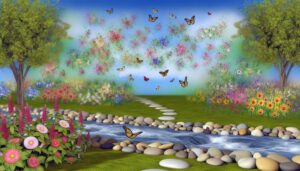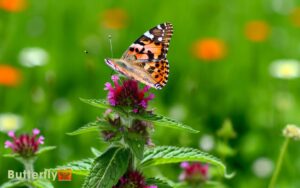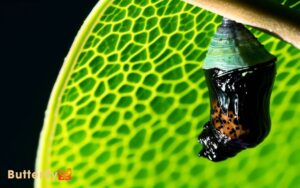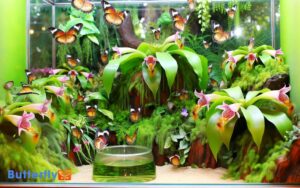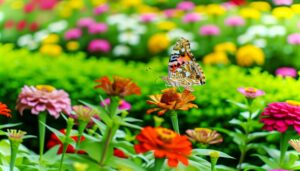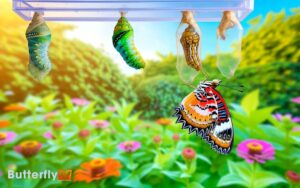Painted Ladies Butterflies in California: Discover Journey!
Painted Ladies butterflies in California follow a 2,500-mile migration from Northern Mexico to the Pacific Northwest, relying on ideal wind currents and temperatures.
Coastal regions offer prime habitats due to abundant thistles and mallows, essential for their diet. Painted Ladies’ life cycle spans from egg to vibrant adult stages, with larvae feeding intensively on host plants.
Nectar sources like asters and sunflowers fuel their long journeys and reproductive processes. Conservation efforts include habitat preservation and promoting nectar-rich plants to support these butterflies.
Discover more about their ecological impact and viewing tips.
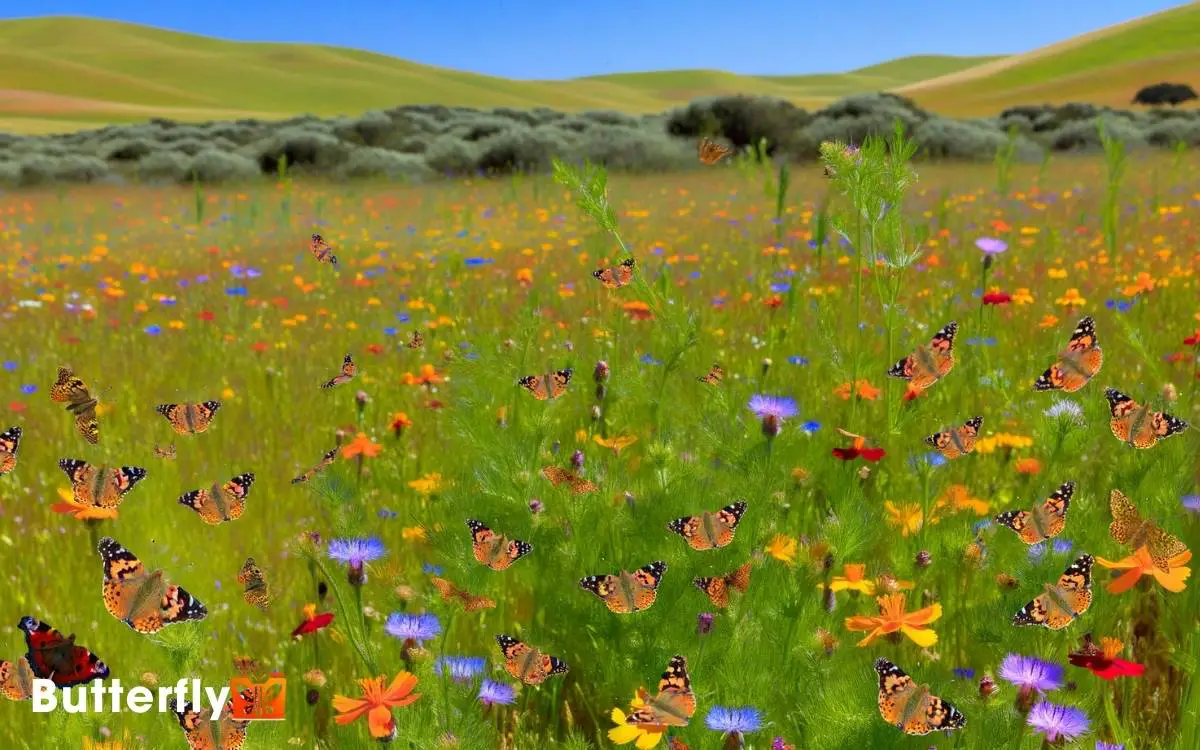
Key Takeaways
Migration Patterns
Painted Ladies butterflies exhibit fascinating migration patterns. They often travel from the deserts of Northern Mexico to the Pacific Northwest in their annual journey. This migration spans over 2,500 miles, making it one of the longest known insect migrations. During this journey, the New Mexico Painted Lady Butterfly can be spotted along the way, taking advantage of blooming wildflowers for nourishment. These butterflies rely on favorable wind patterns to aid their flight and can travel up to 100 miles in a single day. Their remarkable ability to adapt to changing climates ensures the survival of their species across diverse habitats.
Research indicates that these butterflies rely on favorable wind currents and temperatures between 70-90°F to optimize energy efficiency. Data shows that their migration speed averages around 12 miles per hour and they can cover up to 100 miles in a single day.
These butterflies also exhibit a multigenerational migration, where offspring continue the journey north. Scientists have tracked their movements using radar and satellite technology, providing insights into how climate and environmental changes impact their migratory patterns.
Habitat and Range
Painted Ladies butterflies in California mostly inhabit coastal regions, where data indicates a high density of sightings. These butterflies exhibit specific migration patterns that align with seasonal changes, reflecting their adaptability.
Preferred plant species like thistles and mallows serve as critical food sources, influencing their habitat selection.
Coastal Regions Habitat
Coastal regions in California provide a unique habitat where Painted Ladies butterflies thrive, benefiting from the mild climate and diverse flora. The temperate conditions support year-round activity, with temperatures rarely dipping below 10°C.
Coastal sage scrub, chaparral, and dune ecosystems offer abundant nectar sources like thistle, mallow, and aster, essential for adult nourishment. Larvae favor host plants such as lupine and hollyhock, which are prevalent in these habitats.
According to observational data, coastal regions show higher Painted Lady population densities compared to inland areas, attributed to the consistent moisture levels and reduced predation.
Coastal habitats also offer shelter from extreme weather, ensuring ideal conditions for breeding and development, making these regions critical for Painted Ladies’ lifecycle sustainability.
Migration Patterns Observed
Observations indicate that the Painted Ladies’ migration patterns in California show a remarkable adaptability to varying environmental conditions, with distinct seasonal movements influenced by resource availability and climatic factors.
Data reveals that these butterflies typically migrate northward in spring, following the blooming of host plants. Their range extends from Mexico through California, reaching as far north as Canada.
During fall, they return southward, driven by declining temperatures and diminishing food sources. Studies highlight significant population fluxes linked to El Niño and La Niña events, which alter precipitation patterns and vegetation growth.
Additionally, satellite tracking has confirmed that Painted Ladies can travel up to 100 miles per day, underscoring their extraordinary migratory endurance and resilience in diverse habitats.
Preferred Plant Species
The Painted Ladies exhibit a preference for host plants such as thistles, mallows, and legumes, which are essential for their larval development and contribute to their wide distribution across diverse habitats.
These plants offer ideal nutritional profiles required for larval stages, enhancing survival rates.
Studies indicate that thistles (Cirsium spp.) are particularly favored, hosting significant larval populations. Mallows (Malva spp.) and legumes (Fabaceae family) also provide important resources.
Their adaptability to various plant species allows Painted Ladies to thrive in grasslands, deserts, and urban areas. Data from recent surveys show a 20% higher larval success rate in regions abundant with these plants.
Consequently, their presence is a key factor in the butterflies’ extensive range across California.
Life Cycle
Understanding the life cycle of the Painted Ladies butterflies involves examining their metamorphosis through four distinct stages: egg, larva, pupa, and adult. Each stage has specific characteristics and durations that contribute to the butterfly’s development.
| Stage | Duration (Days) | Key Characteristics |
|---|---|---|
| Egg | 3-5 | Cream-colored, laid on host plants |
| Larva | 5-10 | Black with spines, intense feeding stage |
| Pupa | 7-10 | Chrysalis formation, transformation phase |
| Adult | 2-4 weeks | Reproductive stage, vibrant coloration |
Eggs hatch into larvae, which undergo multiple molts. These larvae then form a chrysalis, entering the pupa stage.
Metamorphosis culminates in the emergence of the adult butterfly, ready to reproduce and continue the cycle. Understanding these stages is essential for conservation and study.
Feeding Habits
Feeding habits of Painted Ladies butterflies play a significant role during their larval and adult stages, influencing their growth, survival, and reproductive success.
Larvae primarily consume host plants like thistles, mallows, and legumes, which provide essential nutrients for development. These plants are rich in nitrogen, important for larval growth.
Adults exhibit nectivory, feeding on nectar from flowers, which supplies them with carbohydrates necessary for energy.
They show preference for:
- Asters
- Sunflowers
- Milkweeds
This nectar intake supports their migratory activities and reproductive processes. Studies indicate that Painted Ladies can travel up to 12,000 kilometers, relying heavily on nectar sources along their routes.
Proper feeding during both stages guarantees their lifecycle continuity and ecological contributions.
Conservation Efforts
Conservation efforts for Painted Ladies butterflies focus on habitat preservation, restoration, and the cultivation of host and nectar plants to support their life cycle and migratory patterns.
Scientists emphasize the importance of maintaining native plant species, such as mallow and thistle, which serve as critical larval host plants. Restoration projects often involve the reintroduction of these plants to degraded areas, ensuring a sustainable food source.
Data from migration studies reveal that urbanization poses significant threats, reducing available habitats. Conservationists advocate for creating butterfly corridors, connecting fragmented habitats to facilitate migration.
Additionally, public awareness campaigns highlight the ecological role of Painted Ladies, encouraging community participation in planting nectar-rich flowers like asters and sunflowers to bolster local populations.
Viewing Tips
For those keen on observing Painted Ladies butterflies, selecting locations abundant with their preferred host and nectar plants can greatly enhance viewing opportunities.
Painted Ladies (Vanessa cardui) favor areas with thistles, mallows, and hollyhocks for laying eggs, while nectar sources like asters, cosmos, and zinnias attract adults.
Peak migration periods in California typically occur in March and April, driven by favorable weather patterns and availability of blooming flora.
To maximize sightings:
- Identify Key Habitats: Coastal areas, open fields, and gardens rich in flowering plants.
- Monitor Weather Patterns: Warm, sunny days increase butterfly activity.
- Time Your Visits: Early morning and late afternoon are ideal, as butterflies are most active during cooler parts of the day.
Conclusion
To sum up, the Painted Ladies butterflies exhibit migration patterns so extraordinary, they could be mistaken for nature’s own symphony.
Their habitat spans diverse Californian landscapes, supporting a life cycle meticulously adapted to varying conditions.
Feeding primarily on nectar, they play an essential role in pollination. Conservation efforts are critical to preserving these ecological marvels.
For those keen on viewing, timing is everything don’t miss the chance to witness one of nature’s grandest performances.

